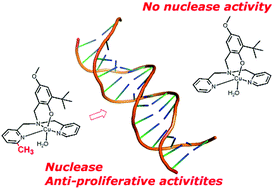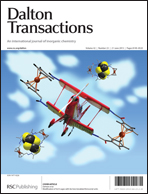Nuclease and anti-proliferative activities of copper(ii) complexes of N3O tripodal ligands involving a sterically hindered phenolate†
Abstract
Copper(II) complexes 12+–6 of a series of tripodal ligands involving a N3O donor set, namely 2-[(bis-pyridin-2-ylmethyl-amino)-methyl]-4-methoxy-phenol (1L), 2-tert-butyl-4-methoxy-6-[bis-pyridin-2-ylmethyl-amino)-methyl]-phenol (2L), 2-tert-butyl-4-methoxy-6-{[(2-pyridin-2-yl-ethyl)-pyridin-2-ylmethyl-amino]-methyl}-phenol (3L), 2-tert-butyl-4-methoxy-6-{[(6-methyl-pyridin-2-ylmethyl)-pyridin-2-ylmethyl-amino]-methyl}-phenol (4L), 2-tert-butyl-4-fluoro-6-{[(6-methyl-pyridin-2-ylmethyl)-pyridin-2-ylmethyl-amino]-methyl}-phenol (5L) and 2-tert-butyl-4-methoxy-6-{bis[(6-methyl-pyridin-2-ylmethyl)-amino]-methyl}-phenol (6L), respectively, were synthesized. Complexes 12+, 3+ and 4+ were structurally characterized by X-ray diffraction. The structure of 12+ is dimeric, with an essentially trigonal bipyramidal geometry around the copper(II) ions and two bridging deprotonated phenolate moieties. The mononuclear complexes 3+ and 4+ contain a square pyramidal copper ion, coordinated in axial position by the phenol moiety. In the water–DMF (90 : 10) mixture at pH 7.3 all the copper(II) complexes are mononuclear, mainly under their phenolate neutral form (except 3+), with a coordinated solvent molecule. The DNA cleavage activity of the complexes was tested towards the ϕX174 DNA plasmid. In the absence of an exogenous agent 12+ does not show any cleavage activity, 2+ and 3+ are moderately active, while 4+, 5+ and 6+ exhibit a high nuclease activity. Experiments in the presence of various scavengers reveal that reactive oxygen species (ROS) are not involved in the strand scission mechanism. The cytotoxicity of the complexes was evaluated on bladder cancer cell lines sensitive or resistant to cisplatin. The IC50 values of the complexes 2+, 4+, 5+ and 6+ are lower than that of cisplatin (range from 6.3 to 3.1 μM against 9.1 μM for cisplatin). Furthermore, complexes 2+, 4+, 5+ and 6+ are able to circumvent cisplatin cellular resistance.


 Please wait while we load your content...
Please wait while we load your content...